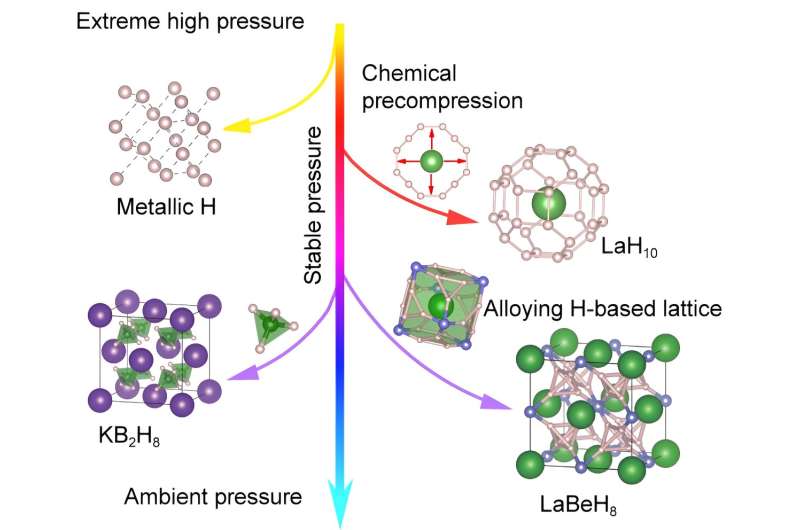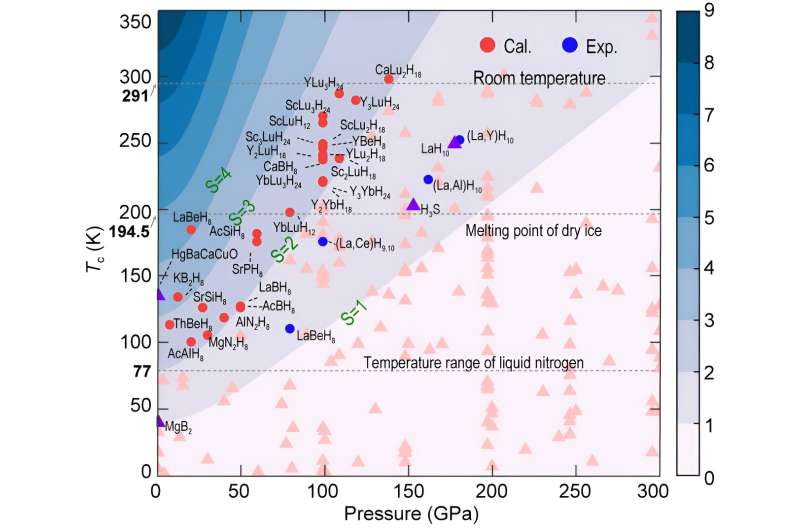This article has been reviewed according to Science X's editorial process and policies. Editors have highlighted the following attributes while ensuring the content's credibility:
fact-checked
trusted source
proofread
New study reviews progress in ternary hydrogen-rich superconductors

Room-temperature superconductivity has been a century-long-held dream of scientists. Hydrogen-rich compounds at high pressures are predicted to be potential high-temperature and even room-temperature superconductors and have become one of the superconducting materials that have received much attention in recent years.
The superconducting transition temperatures of the covalent hydride H3S and ionic clathrate hydrides (LaH10, YH9, YH6) predicted theoretically and synthesized experimentally exceed 200 K, which are the most representative binary hydrides with high-temperature superconductivity.
However, these two typical classes of binary hydrides are usually stable above megabar pressure, which is already much lower than the pressure required for solid hydrogen metallization, but still limits practical applications.
Further lowering the stabilization pressure and increasing the superconducting transition temperature of hydrogen-rich superconductors are important scientific issues in this field.
Ternary hydrides have richer chemical components and crystal structures, promising to synergize the advantages of multiple elements to host unique properties. For example, LaBeH8 can maintain dynamic stability and high-temperature superconductivity below megabar pressure.
The superconducting transition temperatures of ternary clathrate hydrides such as Li2MgH16, Li2NaH17, are much higher than room temperature.
These findings demonstrate that multi-element synergy is an effective strategy to optimize the structure and superconducting properties of hydrogen-rich materials, and encourage the exploration of ternary and multi-component hydrides.
Meanwhile, the complex structures and potential energy surfaces of ternary hydrides increase the difficulty of theoretical predictions and experimental syntheses, facing many opportunities and challenges. It is urgent to further investigate the internal relationship between the structure and properties of such hydrides to promote the exploration of hydrogen-rich high-temperature superconductors.
Prof. Tian Cui of Ningbo University/Jilin University and Prof. Defang Duan's group of Jilin University systematically reviewed the research progress of ternary hydrogen-rich high-temperature superconductors in light of recent research results. The study is published in the journal National Science Review.
They comprehensively revealed the key factors tuning the structural stability as well as the superconductivity of hydrogen-rich materials in terms of crystal structure, electronic structure, and electron-phonon coupling, paving the way for the design and synthesis of novel hydrogen-rich superconducting materials. Subsequently, they highlighted new scientific issues in this field and looked forward to opportunities and challenges for future research.
Focusing on the two key scientific issues of lowering structural stability pressure and improving superconductivity, the authors have revealed the high-pressure tuning, synergistic process and microscopic interaction of the structure and properties of ternary hydrogen-rich compounds.
First, the superconductivity of hydrogen-rich compounds is closely dependent on their special structural motifs, especially the bonding characteristics of the hydrogen sublattice. Hydrogen stabilized in an atomiclike form usually exhibits high electronic density of states at the Fermi level and induces strong electron-phonon coupling.
Therefore, the key to enhancing superconductivity lies in synergizing elements with appropriate radius and electronegativity to keep more hydrogen stabilized in atomiclike forms. For example, the hydrogen atoms in Li2NaH17 acquire a large number of electrons from the metal elements, expanding to form an atomiclike clathrate sublattice that exhibits excellent high-temperature superconductivity.

Meanwhile, the synergistic tuning of multiple elements may induce Fermi surface nesting and softening of phonon modes, features that are favorable for further enhancing electron-phonon coupling.
On the other hand, the alloyed hydrogen sublattice is more likely to be stabilized at moderate pressures and maintain high-temperature superconductivity. For example, LaBeH8 contains a fluorite-type hydrogen alloy lattice composed of the lightweight elements Be and H, with critical temperature Tc up to 110 K measured experimentally at 80 GPa.
Furthermore, the authors have emphasized that s-d boundary metal elements, heavy rare earth elements containing f electrons, and solid-solution hydrogen alloys play an important role in optimizing the structure and properties of hydrides. Ternary and multi-component hydrides represent the next frontier in the exploration of superconducting hydrides.
The development of high-performance algorithms such as crystal structure prediction, machine learning, and high-pressure experimental techniques will promote the exploration of multi-component hydrides. It is expected that there will be more new breakthroughs in the design and synthesis of new superconducting hydrides.
Prof. Tian Cui and Prof. Defang Duan are the co-corresponding authors of this work.
More information: Wendi Zhao et al, Superconducting ternary hydrides: progress and challenges, National Science Review (2024). DOI: 10.1093/nsr/nwad307
Provided by Science China Press





















